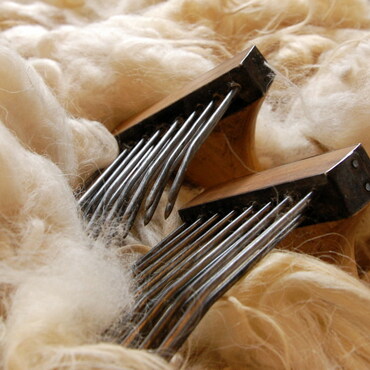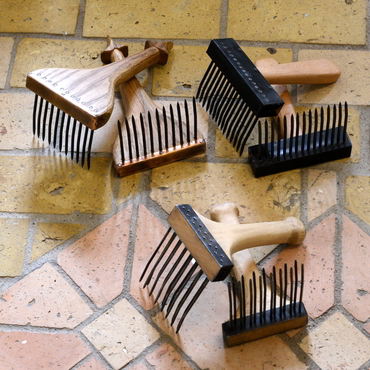The discovery was made by Uppsala University's textile archaeologist Annika Larsson while recreating textile patterns for the exhibition "Viking Couture" at Enköping Museum. According to Larsson, the patterns "resembled nothing she had come across in Scandinavia before", but after a while she remembered seeing "similar designs [...] in Spain, on Moorish textiles".
One word that kept recurring was the name "Ali", who was the fourth caliph of Islam and very close to the prophet Muhammad. A second one appearing together with the first was "Allah", but in mirrored lettering. The script seems to appear in at least 10 out of nearly 100 textile pieces. They are worked in silk and silver threads and appear in grave contexts with a comparatively high percentage of silk fabrics. Larsson suggests that this might reflect Islamic influences on Viking Age burial customs. They wouldn't be the first Kufic characters to be discovered in Scandinavian Viking Age graves. Among the Birka finds, a silver ring with the words "for Allah" inscribed in a gem stone has been found in a female grave.
However, there are voices being raised doubting Larsson's interpretation. Medieval Islamic art and archaeology professor Stephennie Mulder states that the patterns aren't Kufic script. She says that the geometric pattern on the band could at best be identified as square Kufic which didn't exist until after the 15th century. And even if it did, the writing in the bands wouldn't say "Allah"; instead, they wouldn't make any sense at all. She also criticizes Larsson's method of extrapolating the woven pattern in a "convenient" way, thereby basing the text on "extensions of patterns, not on existing patterns".
Larsson's answer to this sounds like an argumentation based on doubtful "evidence". She talks about "secret messages" and that she has "spoken to Muslims" that tell her that "even today sometimes you don’t want to say/write/depict...God’s name [clearly], so then you can make it like a puzzle, and even mirror it." She thinks "that is what [the Vikings] have done on these ribbons."
Here are some more news articles on the topic: BBC, archaeology news network and The New York Times.
Some thoughts about this for the re-enactor
If what Larsson suggests is true, are there any consequences for the re-enactor? Well, this partly depends on the results of the DNA analysis of the skeletons from the graves in question. Here are some suggestions for an ideal way of doing things:
If there are no results (which mainly depends on the ancient DNA's preservation status) and the origin of those Dead remains unknown, one should check the other items from the graves, check the scientific literature on those, then define a relative likelihood of ethnic origin. If the result from this analysis agrees with the persona one wants to portray, then elements from the graves, including the tablet woven bands with Kufic letters, may be adopted to a varying degree.
If the DNA analysis suggests a Scandinavian origin, then we might deal with Viking Age Scandinavians with extensive contacts who adopted the clothing and perhaps part of Islamic ideology. Or we might deal with Viking Age Scandinavians just borrowing certain elements, maybe understanding the underlying symbolism, maybe not. Again, one should choose according to the persona portrayed. If the graves in question held people of Persian/Central Asian origin, however, one should use replicas of those bands either very carefully and sparsely or not at all.
Of course, it's always possible to just pick up things that look pretty and seem to fit one's persona's status without deeper analysis. Many of us do that. But one should always keep in mind the uncertainties connected to these choices, if known, and strife to improve the historical picture given.
One more thing...
The example of the Kufic prayers or non-Kufic gibberish (depending on whose opinion you favour at the moment) on the tablet woven bands teaches us something about news from the researchers we rely upon: First, the researchers are only human, too, trying to find the truth and sometimes making mistakes along the way. It is okay to question all findings - if they are questioned wisely (in the same manner, one should always question one's own theories and common practices in the Living History scene). Second, be patient, especially if the news are "outstanding". There might always be some flaw the science community isn't aware of yet. The real discussion might start after a while. And a sensible discussion is one of the most important tools in the process of finding the truth. Since sensationalistic media coverage often distorts this discussion, it is advisable to seek out original sources where possible.
update 21st October 2017
- according to the historical linguist Marijn van Putten, the silver ring from Birka does not say "for Allah". Here's why.
- Uppsala University realizes that they should have stated more clearly that the results were of preliminary nature... Link (in Swedish)
- some Spanish textiles with square Kufic letters are depicted in this article . Also, there is a short paragraph on the political importance of this topic at the end of the article.
update 28th October 2017
- Stephennie Mulder has published an article where she lays out her reasoning against the Viking "Allah" textile without using five dozens of twitter posts. She also has some remarks to what the story tells us about our current media landscape.



